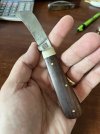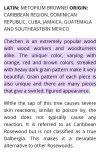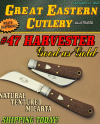All I could find was a very short film about how cotton changed Poteau, Oklahoma. It mentioned that bales of cotton were brought to the market place on horse drawn wagons and a small incision was cut in the bottom of the bales to sample quality.
Why any sharp knife wouldn't do the job is something of a mystery? Yet the Cotton Sampler has this very distinctive shape, perhaps it is to take a round, uniform plug out of the bale rather than stabbing into it?
There must be Americans here who have direct connexions or exp. with cotton farming and can shed light? Interesting that it's Europeans who are curious

Of course, it could be the Cutlery industry seeing a promising niche to promote a must have tool back in more agricultural days? A kind of cutlers' whimsy at a time when pocket-knives of various sorts were ubiquitous. Bit like the Melon Tester whose actual use could be dubious...they do look cool though. Whether such knives were widely used for such a purpose must remain conjecture.
I do know that the 2 mini samplers I have from RR are very promising hard sausage/salami slicers!



